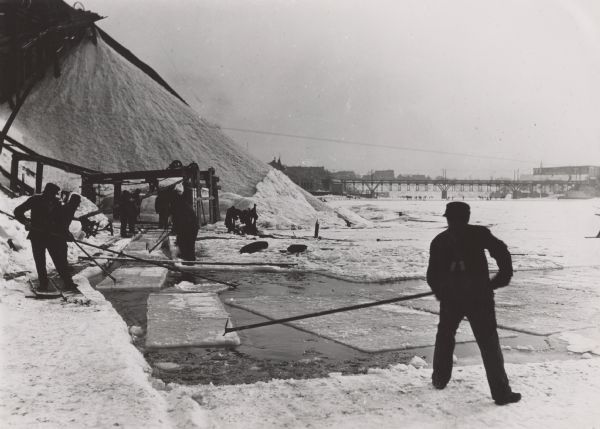It was a crop that required no seeds. No one had to turn over a single furrow of earth or pull a solitary weed. Year after year, it was simply there, available to anyone with the right equipment, and it began to grow again the minute the harvest was done.
This miraculous crop was … ice. If you’re tired of winter, try to remember that cold weather once supported an important Wisconsin industry. Without ice, thousands of households and some major industries would have been seriously inconvenienced.
The ice kings of southern Wisconsin were John Kopmeier and his descendants. Their annual harvest climbed from 4,000 tons in 1878 to 400,000 in 1900. Much of it was cut in their hometown on the Milwaukee River, but the Kopmeiers developed a network of more than 100 icehouses on lakes many miles inland.
The harvest followed the same steps in every case. As soon as the ice was thick enough—a foot was good, 18 inches even better—horses with spiked shoes were harnessed to single-bladed “ice plows” with outriggers attached. Each blade cut a deep groove in the ice, and the outrigger neatly scribed the line of the next cut.
When the entire field had been “plowed,” horses and men repeated the process at right angles to their first path, creating a checkerboard of ice blocks that could be sawed or chiseled loose with relative ease. Workers with long-handled pike poles pushed the ice down open channels to horse-powered conveyors, which lifted the blocks into icehouses on the water’s edge.
The icehouses were double-walled buildings insulated, like the ice blocks themselves, with thick layers of sawdust—a material of prodigal abundance in nineteenth-century Wisconsin. With enough sawdust packed around it, ice could last for more than a year in storage.
For most consumers, ice was a luxury at first, something the wealthy used to cool their food, make ice cream, or add just the right chill to their mint juleps. For two major Milwaukee industries— brewing and meat-packing—it was a necessity. Because lager beer had to ferment and age at cool temperatures, it was a seasonal activity at first. Most Wisconsin brewers made beer in winter and sold it in summer, using icehouses or artificial caves to keep their kegs cool.
Ice was just as important for local meat-packers. Pork and beef had always been cured in salt, but the advent of ice shifted the emphasis to fresh meat. In 1879 Patrick Cudahy built an icehouse in Milwaukee’s Menomonee Valley and instantly had a year-round enterprise. Before long, every major packer was slaughtering, packing, and shipping meat with the assistance of ice.
Business was good well into the twentieth century, but machines eventually killed the ice trade. The Pabst brewery installed its first artificial refrigeration unit in 1880, and by 1889 the company had stopped harvesting natural ice altogether.
Residential customers made the same switch, buying machine-made ice at first and then replacing their iceboxes with refrigerators. More than a fourth of the Milwaukee area’s homes had refrigerators in 1936. By 1950 the proportion neared 100 percent.
The icefields are idle today. Frozen lakes and frozen rivers attract snowmobilers and fisherfolk, but no one comes with thoughts of harvest. Not even memories remain of an industry, and a way of life, that simply melted away.











